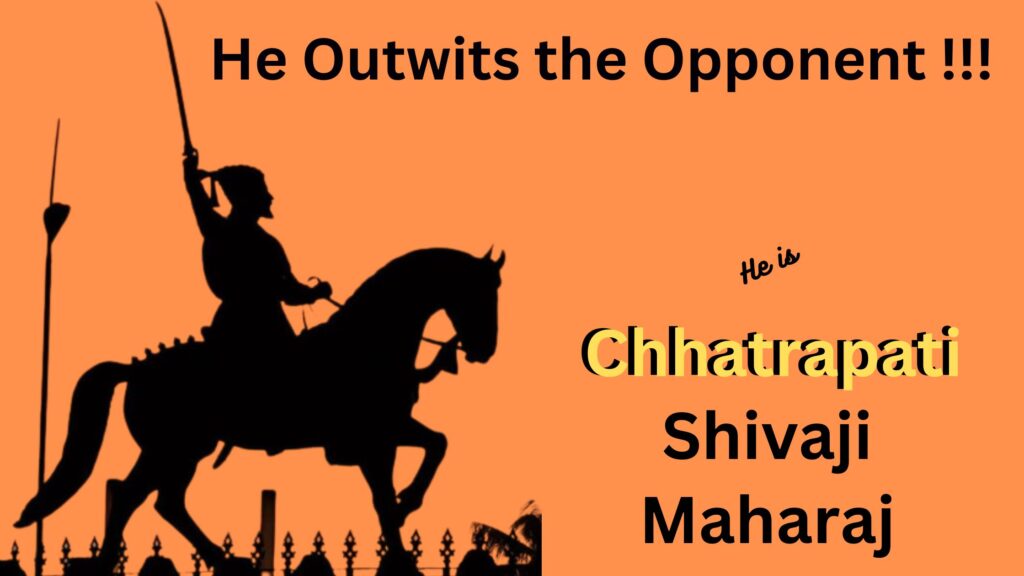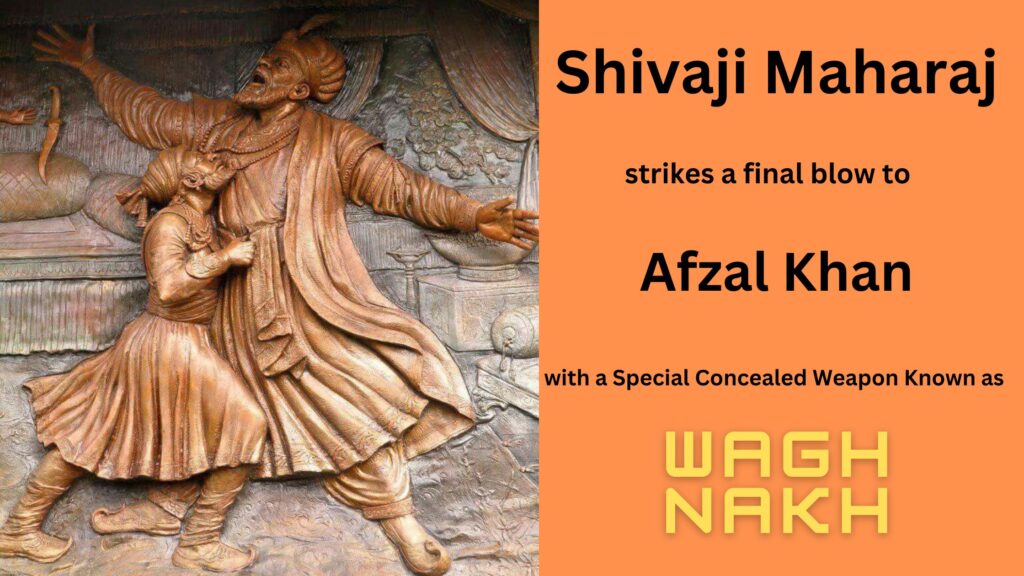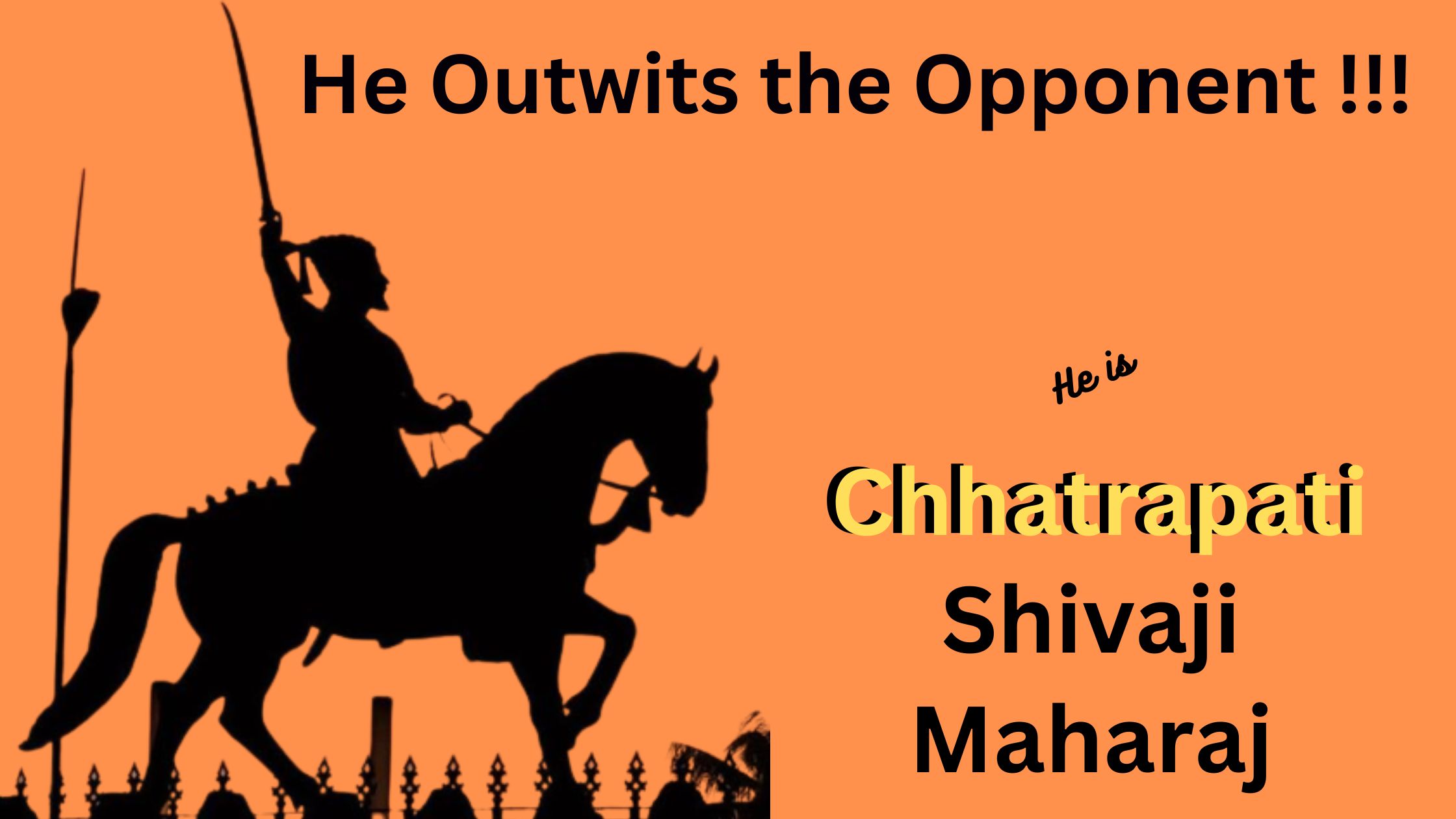Explore the riveting encounter between Chhatrapati Shivaji and Afzal Khan, delving into their strategic manoeuvres, cunning tactics, and the climactic showdown that reshaped Maratha history. Uncover the political landscape, religious fervor, and the legacy of this pivotal confrontation.
Introduction: Setting the Stage for Conflict
In the annals of Maratha history, the encounter between Chhatrapati Shivaji Maharaj and Afzal Khan stands as a testament to strategic brilliance, cunning tactics, and an unyielding spirit. As Shivaji Maharaj embarked on his mission for Hindavi Swarajya, a Hindu self-rule, the establishment of a Hindu kingdom posed a direct challenge to the dominance of the Mughal Empire and the Adilshahi Sultanate. This collision of ambitions would ignite a series of events that would forever alter the course of the Deccan region.
The Arrest of Shahaji Raje
The arrest of Shivaji’s father, Shahaji Raje, by Afzal Khan during the siege of Gingee in 1649 had a profound impact. This event not only showcased Afzal Khan’s audacity but also sparked a series of events that would lead to a climactic showdown.
Shivaji Maharaj’s Determination
Shivaji Maharaj’s response to his father’s arrest was marked by a strong determination. He recaptured Kondhana Fort and embarked on a journey to establish his own kingdom, undeterred by the challenges posed by Afzal Khan and the Adilshahi Sultanate.
The Tragic Loss of Sambhaji
In a tragic turn of events, Afzal Khan’s cruelty reached its peak when he orchestrated the death of Sambhaji, Shahaji Raje’s eldest son, in 1655. This act of brutality further fuelled Shivaji Maharaj’s resolve to confront Afzal Khan.

Muhammad Adilshah’s Death and Power Vacuum
As the Adilshahi Sultanate grappled with the aftermath of Muhammad Adilshah’s death, Chhatrapati Shivaji recognized an opportune moment to advance his ambitions. This phase of uncertainty paved the way for Shivaji Maharaj to make strategic moves that would shape the trajectory of his empire.
Muhammad Adilshah’s Demise and the Power Struggle
Following Muhammad Adilshah’s death on 4th November 1656, the Adilshahi Sultanate plunged into turmoil. The ascension of Ali, his 18-year-old son, was met with challenges as the Mughal Empire under Shah Jahan and Aurangzeb saw an opportunity to expand their influence.
Mughal Intervention: A Chaotic Scenario
Recognizing the vulnerability of the Adilshahi Sultanate, Shah Jahan and Aurangzeb initiated an invasion. They aimed to capitalize on the internal strife and territorial vacuum caused by Muhammad Adilshah’s death, further intensifying the chaos in the region.
Shivaji Maharaj’s Calculated Moves
In the midst of the power struggle between the Mughals and the Adilshahi Sultanate, Shivaji Maharaj saw an opening to assert his influence. He began capturing territories belonging to both factions, displaying his strategic brilliance and audacity.
Expanding Influence: Shivaji Maharaj’s Conquests
Shivaji Maharaj’s campaigns were relentless. His recapture of Kondhana in August 1657 and his successful campaigns against the Siddi demonstrated his commitment to expanding his empire’s boundaries.
Moreover, His conquests in the North Konkan region, reclaiming nearly thirty forts that were originally part of the Nizamshahi Sultanate, further solidified his grip on the area.
Mughal Focus Shift: Shivaji Maharaj’s Advantage
With the Mughal invasion in full swing, Aurangzeb’s departure for northern India to claim the Mughal throne diverted attention away from Shivaji Maharaj’s endeavours.
This shift allowed Shivaji to consolidate his gains and reinforce his position within the chaotic landscape of the Deccan region.
Shahaji’s Denial and Silent Support
Shahaji Raje’s denial of responsibility for Shivaji’s actions before the Bijapur court was more than just evasion. It indicated a tacit endorsement of his son’s cause and the broader Hindu agenda.
Ali Adilshah’s Opposition to Shivaji Maharaj
While the official history of Ali Adilshah’s reign, the Tarikh-i-Ali, confirms his opposition to Shivaji Maharaj, it underscored the challenges both he and Badi Sahiba faced in trying to eliminate Shivaji Maharaj.
Afzal Khan’s Acceptance and Strategy
In a daring turn of events, Afzal Khan accepted Shivaji Maharaj’s challenge, setting the wheels in motion for a dramatic clash of titans. The Bijapur Sultanate, however, was reeling from the aftermath of the Mughal invasion of 1657, limiting Khan’s military capabilities to a mere 10,000 soldiers. On the contrary, Shivaji Maharaj commanded a significantly larger force, giving him a numerical advantage. Afzal Khan, recognizing his disadvantage, chose not to engage in an open contest of force. Instead, he opted for a deceitful strategy, exploiting Shivaji Maharaj’s trust to orchestrate a betrayal that would alter the course of history.
Afzal Khan: Cruelty and Religious Bigotry
As the stage was set for the encounter, Afzal Khan’s true nature was unveiled. Known for his cruelty and religious fanaticism, Khan’s brutal disposition became evident through inscriptions and contemporary accounts. He earned a sinister reputation for the destruction of Hindu temples and his fervent disregard for religious diversity. The stark contrast between his disposition and Shivaji Maharaj’s ethos would only magnify the impending clash.
The Ambush: Shivaji Maharaj’s Calculated Ploy
Shivaji Maharaj’s strategic brilliance would shine in the subsequent events. Orchestrating an ambush that would become a turning point, his meticulous planning revealed itself during the fateful meeting. Afzal Khan, underestimating Shivaji Maharaj’s capabilities, remained unaware of the hidden infantry strategically positioned around the meeting site. This ingenious move would play a crucial role in the climactic confrontation.
Unraveling the Confrontation: The Face-off
The moment of confrontation between Shivaji Maharaj and Afzal Khan is etched in history with vivid detail. As the two leaders met, tension hung in the air. Afzal Khan, towering in stature, sought to overpower Shivaji Maharaj with his physical presence and deceitful charm. Shivaji Maharaj, relying on his intellect and strategic acumen, knew that a direct physical contest could be perilous.
Shivaji Maharaj’s Anticipation
The cunning scheme orchestrated by Shivaji Maharaj began to unfold as the leaders exchanged pleasantries. Recognizing Afzal Khan’s intent to overpower him physically, Shivaji Maharaj wore a concealed armour beneath his clothing. This armour, known as “bakhna,” would become his shield against Afzal Khan’s attack.
Shivaji Maharaj’s Defense
The dramatic turn of events that followed showcased the clash of intellect, strategy, and sheer determination. As Afzal Khan attempted to strike Shivaji Maharaj with a concealed dagger, he encountered an unexpected resistance. Maharaj’s armour absorbed the blow, leaving Khan momentarily baffled.
Shivaji Maharaj’s attack
In a swift countermove, Maharaj drew a “waghnakh” – a weapon with sharp, tiger-claw-like attachments – and struck Afzal Khan’s abdomen. The blow was fatal, and Afzal Khan fell, mortally wounded.

Chaos and Maratha Resurgence
The shock of Afzal Khan’s demise plunged his forces into chaos. Shivaji Maharaj’s hidden infantry, strategically positioned, sprang into action, attacking the disoriented Adilshahi troops. The ambush showcased Maharaj’s ability to not only outwit his adversaries but also to execute a meticulously planned military manoeuvre.
The Maratha warriors, fuelled by their leader’s strategic brilliance and their own unwavering commitment, launched a relentless assault on the disarrayed enemy ranks. The coordinated attack demonstrated the discipline and unity that defined the Maratha forces. The clash that had begun as a face-to-face encounter evolved into a dynamic battle that tested the mettle of both sides.
Shivaji Maharaj’s Legacy
The legacy of the confrontation reverberated through history, leaving an indelible mark on the Deccan’s political landscape.The impact of Shivaji’s strategic triumph reached even the mighty Aurangzeb, who had ascended to the Mughal throne.
Aurangzeb’s Realisation
Recognizing the Marathas as a formidable adversary, Aurangzeb acknowledged the shifting dynamics and the emergence of a new power in the region. The clash between Shivaji and Afzal Khan marked the beginning of a larger narrative that would shape the course of Indian history.
Strategic Brilliance vs. Deceitful Tactics
The confrontation between Shivaji and Afzal Khan was more than just a physical battle; it was a clash of ideologies, strategies, and values. Shivaji’s meticulous planning and calculated risk-taking demonstrated his strategic brilliance. He understood the importance of leveraging his strengths and exploiting his opponent’s weaknesses. On the other hand, Afzal Khan’s deceitful approach revealed his desperation and inability to match Shivaji’s military acumen.
Shivaji’s Leadership and Maratha Identity
The confrontation also showcased Shivaji’s leadership skills and his commitment to defending the Maratha identity. His ability to rally his troops, strategies effectively, and maintain the trust of his followers was a testament to his charismatic leadership. The victory over Afzal Khan bolstered the confidence of the Maratha warriors and solidified Shivaji’s position as a symbol of resistance against foreign domination.
Conclusion: Strategic Triumph and Lasting Impact
In the annals of history, the encounter between Chhatrapati Shivaji Maharaj and Afzal Khan remains a defining moment that encapsulates courage, strategy, and determination. Shivaji’s ability to outwit Afzal Khan through a carefully orchestrated ambush speaks volumes about his tactical prowess. This confrontation wasn’t just about the victory of one man over another; it was about shaping the destiny of a region and the emergence of a formidable force that would leave an indelible mark on India’s history.
As we delve into the pages of history, the story of Shivaji Maharaj’s triumphant encounter with Afzal Khan continues to inspire and educate us about the importance of strategic thinking, leadership, and the unwavering pursuit of one’s ideals.
Frequently Asked Questions (FAQs)
Who was Chhatrapati Shivaji Maharaj?
Chhatrapati Shivaji Maharaj was a legendary Maratha warrior and the founder of the Maratha Empire in western India. He is revered for his strategic brilliance, administrative acumen, and commitment to self-rule.
What was the significance of Shivaji Maharaj’s quest for Swarajya?
Shivaji Maharaj’s quest for Swarajya, or self-rule, marked a crucial movement against foreign dominion. It ignited a wave of resistance against the Mughal Empire and Deccan Sultanates, eventually leading to the establishment of the Maratha Empire.
Who was Afzal Khan, and what role did he play in Shivaji Maharaj’s story?
Afzal Khan was a prominent Adilshahi commander who sought to suppress Shivaji Maharaj’s uprising. He played a pivotal role in the climactic confrontation with Shivaji, driven by arrogance and deceit.
What led to the face-off between Shivaji Maharaj and Afzal Khan?
The face-off was a culmination of rising tensions between Shivaji Maharaj’s growing influence and Afzal Khan’s efforts to subdue the Maratha leader. The power vacuum following Muhammad Adilshah’s death further intensified the conflict.
How did Shivaji Maharaj outwit Afzal Khan?
Shivaji Maharaj donned concealed armour, known as “bakhna,” to protect himself from Afzal Khan’s treacherous attack. This tactical move allowed him to withstand the initial assault and turn the tide in his favor.
What weapon did Shivaji Maharaj use to counter Afzal Khan’s attack?
Shivaji Maharaj drew a “waghnakh,” a weapon with claw-like attachments, to counter Afzal Khan’s assault. This choice of weapon showcased his preparedness and determination to defend himself.
How did the confrontation between Shivaji Maharaj and Afzal Khan unfold?
The confrontation began with tension as Afzal Khan sought to overpower Shivaji Maharaj. However, Maharaj’s concealed armour “bakhna” deflected the initial attack, allowing him to launch a swift countermove with his weapon “wagh nakh” that proved fatal for Afzal Khan.
What impact did Shivaji Maharaj’s victory over Afzal Khan have on history?
Shivaji Maharaj’s victory symbolised the triumph of valor, strategy, and justice. It marked a turning point in the Maratha resurgence and solidified Maharaj’s legacy as a visionary leader who defied tyranny.
How did Shivaji Maharaj’s nobility contrast with Afzal Khan’s cruelty?
While Afzal Khan was known for religious fanaticism and brutality, Shivaji Maharaj’s nobility was evident through his inclusive policies, protection of cultural heritage, and respect for diversity.
What lessons can be drawn from the Shivaji Maharaj -Afzal Khan confrontation?
The confrontation underscores the importance of strategic brilliance, courage, and the indomitable human spirit. It serves as a reminder that history is shaped by individuals who rise above adversity with integrity and vision.
What attire did Shivaji Maharaj wear for defence and attack during the face-off?
Shivaji Maharaj donned concealed armour known as “bakhna” to defend against Afzal Khan’s attack. He countered the assault with a “waghnakh,” a weapon representing his determination to protect his cause.
